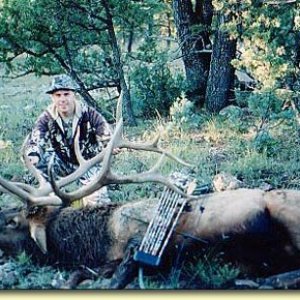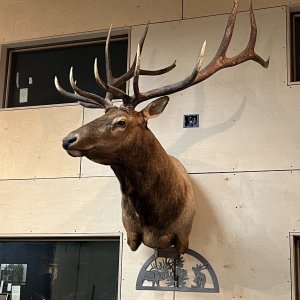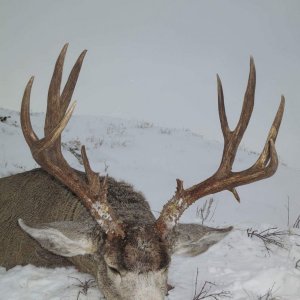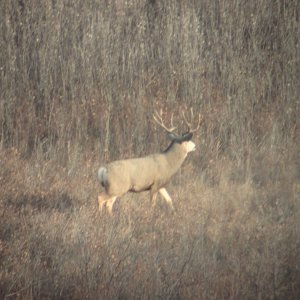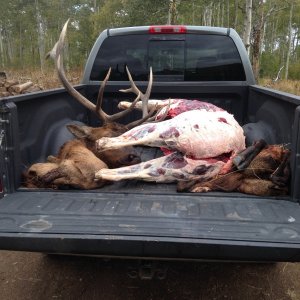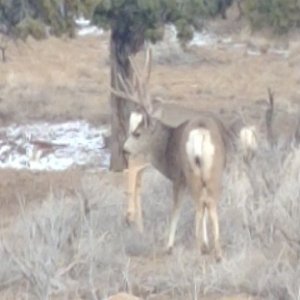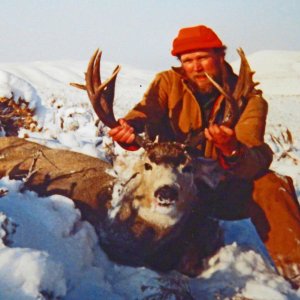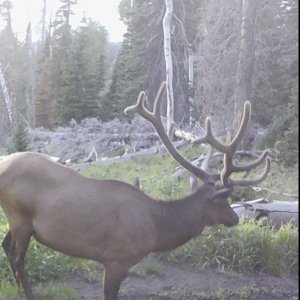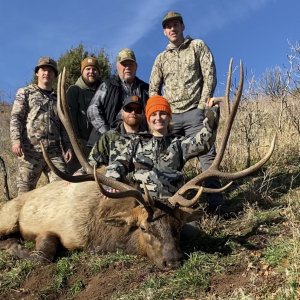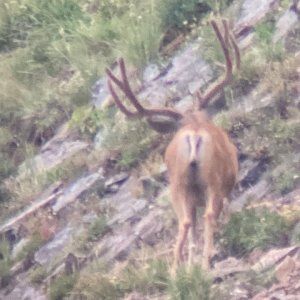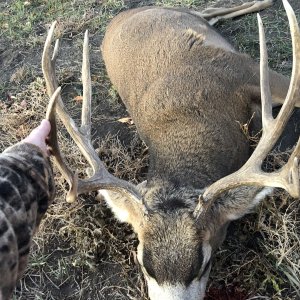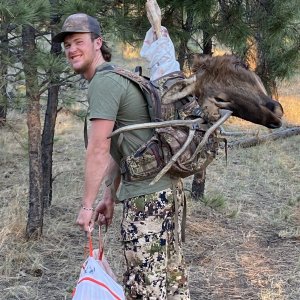T
TFinalshot
Guest
Dont shoot the messanger, shoot the message. . .
Elk prefer people on foot
Study finds ATVs, bikes disturb them most.
By Cory Hatch
Date: February 21, 2007
Ongoing research into how recreation affects wildlife shows that ATVs, then mountain bikes, have the largest impact on elk, while hiking and horseback riding have the least effect.
Forest Service researchers in Northwest Oregon found that elk were more likely to flee, and more likely to flee faster, from ATVs ? all terrain vehicles ? than other forms of recreation. Mule deer, on the other hand, seem mostly unphased by humans in the forest.
The research could have important implications for local forest planners as they establish a motorized trail system in the Bridger-Teton. Michael Wisdom, lead author of the study, will join a panel of local and regional experts to discuss motorized use on area forest lands tonight at the Teton Science Schools.
Wisdom and his colleagues radio collared 12 elk and 12 deer on the 3,590-acre Starkey Experimental Forest and Range, located 28 miles southwest of La Grande, Oregon. For five days in a row, once in the morning and once in the evening, test subjects wearing Global Positioning System tracking devices would hike or ride ATVs, bikes, or horses on approximately 20 miles of trails that snaked through the forest. Each trial period was then followed by nine days without any human presence.
According to Wisdom, ATVs during the morning hours drew the strongest response from elk, causing animals to flee at a rate of 21 yards per minute, followed by mountain bikes at 17 yards per minute, and horses and hikers at 15 yards per minute.
According to Wisdom, elk activity took a sharp dip around noon during the five-day trial periods. "That's when we take our lunch break," he explained in a telephone interview.
In the afternoon hours, ATVs still topped the disturbance list, causing animals to move at 13 yards per minute, followed by horseback riding at 11 yards per minute and hiking and mountain biking at 10 yards per minute.
Wisdom said elk movement in the afternoon likely decreased because the animals had already begun to shift farther away from the routes.
"It's a natural way they would redistribute themselves and reduce their energy loss during the periods when we were running these activities," he said. "It was still, for the most part, above the control period; they would simply just stay farther away."
During the nine-day control periods, with no human activity, elk movement rates varied between four and 11 yards per minute, depending on the time of day.
With ATVs and mountain bikes, elk not only fled faster but more often and farther. The probability of flight continued beyond 1,640 yards compared to 820 yards with horseback riders and 550 yards with hikers.
While a few scattered elk may not seem like a big deal, Wisdom explained that elk running from humans spend less time eating.
"If we had enough increased energetic costs during the spring, summer, and fall from the various recreation activities, such that animals don't put on enough body fat, they might not survive the winter period," he said.
Indeed, when researchers used activity monitors embedded in radio collars to find out where and when animals foraged, there was a reduction in the time spent feeding during recreation and an increase in the time spent moving. "All of those things have energetic consequences for the animal," Wisdom said.
While recreation didn't have a large direct effect on mule deer movement, the researchers found that the deer tended to move closer to the roads during periods of activity. The deer are likely moving closer to human disturbance to avoid commingling with elk that have moved to more remote areas.
"These results were not surprising in that we have found that elk are more sensitive in reacting to motorized uses and human activities in general," Wisdom said. "Mule deer don't care about traffic or roads as much as they are avoiding elk."
According to Wisdom, the most important finding in the study is that all four forms of recreation have some effect on elk in the forest. Agencies like the Forest Service might use the data to come up with ways to mitigate the impact of recreation.
"Those four forms of off-road recreation have effects," he said. "They all resulted in increased movement rates, reduced feeding time, and distribution shifts away from the routes by elk. All of these [types of recreation] probably need to be considered in total when you are planning for recreation management and access management."
Wisdom also said that land management officials should consider "recreational equivalents," or how much trail each type of recreation actually uses in a day. Where two ATV riders could easily cover the 40 miles of trail during a 12-hour period, it took twice as many mountain bikers and three times as many horseback riders or hikers to cover the same distance during the study.
Elk prefer people on foot
Study finds ATVs, bikes disturb them most.
By Cory Hatch
Date: February 21, 2007
Ongoing research into how recreation affects wildlife shows that ATVs, then mountain bikes, have the largest impact on elk, while hiking and horseback riding have the least effect.
Forest Service researchers in Northwest Oregon found that elk were more likely to flee, and more likely to flee faster, from ATVs ? all terrain vehicles ? than other forms of recreation. Mule deer, on the other hand, seem mostly unphased by humans in the forest.
The research could have important implications for local forest planners as they establish a motorized trail system in the Bridger-Teton. Michael Wisdom, lead author of the study, will join a panel of local and regional experts to discuss motorized use on area forest lands tonight at the Teton Science Schools.
Wisdom and his colleagues radio collared 12 elk and 12 deer on the 3,590-acre Starkey Experimental Forest and Range, located 28 miles southwest of La Grande, Oregon. For five days in a row, once in the morning and once in the evening, test subjects wearing Global Positioning System tracking devices would hike or ride ATVs, bikes, or horses on approximately 20 miles of trails that snaked through the forest. Each trial period was then followed by nine days without any human presence.
According to Wisdom, ATVs during the morning hours drew the strongest response from elk, causing animals to flee at a rate of 21 yards per minute, followed by mountain bikes at 17 yards per minute, and horses and hikers at 15 yards per minute.
According to Wisdom, elk activity took a sharp dip around noon during the five-day trial periods. "That's when we take our lunch break," he explained in a telephone interview.
In the afternoon hours, ATVs still topped the disturbance list, causing animals to move at 13 yards per minute, followed by horseback riding at 11 yards per minute and hiking and mountain biking at 10 yards per minute.
Wisdom said elk movement in the afternoon likely decreased because the animals had already begun to shift farther away from the routes.
"It's a natural way they would redistribute themselves and reduce their energy loss during the periods when we were running these activities," he said. "It was still, for the most part, above the control period; they would simply just stay farther away."
During the nine-day control periods, with no human activity, elk movement rates varied between four and 11 yards per minute, depending on the time of day.
With ATVs and mountain bikes, elk not only fled faster but more often and farther. The probability of flight continued beyond 1,640 yards compared to 820 yards with horseback riders and 550 yards with hikers.
While a few scattered elk may not seem like a big deal, Wisdom explained that elk running from humans spend less time eating.
"If we had enough increased energetic costs during the spring, summer, and fall from the various recreation activities, such that animals don't put on enough body fat, they might not survive the winter period," he said.
Indeed, when researchers used activity monitors embedded in radio collars to find out where and when animals foraged, there was a reduction in the time spent feeding during recreation and an increase in the time spent moving. "All of those things have energetic consequences for the animal," Wisdom said.
While recreation didn't have a large direct effect on mule deer movement, the researchers found that the deer tended to move closer to the roads during periods of activity. The deer are likely moving closer to human disturbance to avoid commingling with elk that have moved to more remote areas.
"These results were not surprising in that we have found that elk are more sensitive in reacting to motorized uses and human activities in general," Wisdom said. "Mule deer don't care about traffic or roads as much as they are avoiding elk."
According to Wisdom, the most important finding in the study is that all four forms of recreation have some effect on elk in the forest. Agencies like the Forest Service might use the data to come up with ways to mitigate the impact of recreation.
"Those four forms of off-road recreation have effects," he said. "They all resulted in increased movement rates, reduced feeding time, and distribution shifts away from the routes by elk. All of these [types of recreation] probably need to be considered in total when you are planning for recreation management and access management."
Wisdom also said that land management officials should consider "recreational equivalents," or how much trail each type of recreation actually uses in a day. Where two ATV riders could easily cover the 40 miles of trail during a 12-hour period, it took twice as many mountain bikers and three times as many horseback riders or hikers to cover the same distance during the study.


